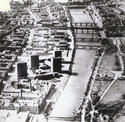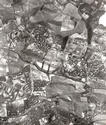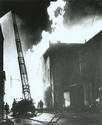 For a television programme in the year 2000, Michael Mair, now a Church of Scotland minister, looked back to the Glasgow of fifty years earlier when he made his way daily to school in the city centre from just outside the boundary in Netherlee: "Glasgow in the days when I was a kid was a dirty place," he said. "The buildings were all black. I thought stone was black. It was actually dirt. George Square was black. There was this smoky pall hanging over the city".
For a television programme in the year 2000, Michael Mair, now a Church of Scotland minister, looked back to the Glasgow of fifty years earlier when he made his way daily to school in the city centre from just outside the boundary in Netherlee: "Glasgow in the days when I was a kid was a dirty place," he said. "The buildings were all black. I thought stone was black. It was actually dirt. George Square was black. There was this smoky pall hanging over the city".
Then and Now
 The Glasgow of 1950 was certainly a far from attractive place, and on many winter nights thick smog enveloped the city so tightly that pedestrians could often see little more than a few yards in front of them. Conditions in the city were hardly conducive to good health, and in 1957, Glasgow launched a mass X-ray campaign aimed at, and largely successful in, eradicating tuberculosis in the city. Thirty-six mobile units were used and in five weeks over 700,000 people were x-rayed. "The figures achieved in Glasgow will go down in medical history," said Bailie John Mains.
The Glasgow of 1950 was certainly a far from attractive place, and on many winter nights thick smog enveloped the city so tightly that pedestrians could often see little more than a few yards in front of them. Conditions in the city were hardly conducive to good health, and in 1957, Glasgow launched a mass X-ray campaign aimed at, and largely successful in, eradicating tuberculosis in the city. Thirty-six mobile units were used and in five weeks over 700,000 people were x-rayed. "The figures achieved in Glasgow will go down in medical history," said Bailie John Mains.
 Towards the end of the century, the journalist Ian Jack was able to write in The Sunday Times that "Some marvellous and intriguing things have been happening in the city. Epidemics of stone cleaning and tree planting have transformed its former blackness into chequer works of salmon pink, yellow and green. Old buildings have been burnished and refitted. Museums, delicatessens and wine-bars have opened and thrive. New theatres occupy old churches. There are business centres, sports centres, heritage centres, arts centres. There are film makers. There is even a nationally acknowledged novelist or two. Its new appearance persuades that it may become Britain's first major post-industrial success."
Towards the end of the century, the journalist Ian Jack was able to write in The Sunday Times that "Some marvellous and intriguing things have been happening in the city. Epidemics of stone cleaning and tree planting have transformed its former blackness into chequer works of salmon pink, yellow and green. Old buildings have been burnished and refitted. Museums, delicatessens and wine-bars have opened and thrive. New theatres occupy old churches. There are business centres, sports centres, heritage centres, arts centres. There are film makers. There is even a nationally acknowledged novelist or two. Its new appearance persuades that it may become Britain's first major post-industrial success."
 The transformation of Glasgow and the gradual growth of its self-confidence was the most significant development in the history of the city in the second half of the 20th century. Perhaps it began with Dr Tom Honeyman's brave decision to purchase Salvador Dali's painting "Christ of St John of the Cross" in 1952. In 1983 a national advertising campaign with the slogan "Glasgow's Miles Better" was launched. Better than what? Better than it was: and the city's image continued to improve. In 1988 Glasgow staged the widely acclaimed Garden Festival, which the city authorities wanted to site on Glasgow Green but was finally housed on the site of disused docks on the south bank of the River Clyde. Two years later Glasgow became European City of Culture. The city failed in its bid to host the Festival of Visual Arts in 1996 but did hold the Festival of Architecture and Design in 1999.
The transformation of Glasgow and the gradual growth of its self-confidence was the most significant development in the history of the city in the second half of the 20th century. Perhaps it began with Dr Tom Honeyman's brave decision to purchase Salvador Dali's painting "Christ of St John of the Cross" in 1952. In 1983 a national advertising campaign with the slogan "Glasgow's Miles Better" was launched. Better than what? Better than it was: and the city's image continued to improve. In 1988 Glasgow staged the widely acclaimed Garden Festival, which the city authorities wanted to site on Glasgow Green but was finally housed on the site of disused docks on the south bank of the River Clyde. Two years later Glasgow became European City of Culture. The city failed in its bid to host the Festival of Visual Arts in 1996 but did hold the Festival of Architecture and Design in 1999.
New Homes
 Glasgow's physical contours began to change in 1953, when the first tenants moved into what were described as the "skyscrapers" of Moss Heights near Hillington. Five years later the Corporation approved Sir Basil Spence's scheme for 19-storey high blocks of flats as the shape of the new Gorbals. The policy of building high rise housing was one factor in the destruction of a group of virtually village communities which made up much of working class Glasgow until the 1960s: Maryhill, Partick, Govan, Gorbals and Ibrox were places where, in some cases until the 1970s, several generations of the same family had grown up and continued to live in these self-contained and self-sufficient communities.
Glasgow's physical contours began to change in 1953, when the first tenants moved into what were described as the "skyscrapers" of Moss Heights near Hillington. Five years later the Corporation approved Sir Basil Spence's scheme for 19-storey high blocks of flats as the shape of the new Gorbals. The policy of building high rise housing was one factor in the destruction of a group of virtually village communities which made up much of working class Glasgow until the 1960s: Maryhill, Partick, Govan, Gorbals and Ibrox were places where, in some cases until the 1970s, several generations of the same family had grown up and continued to live in these self-contained and self-sufficient communities.
 The Housing (Repairs and Rents) (Scotland) Act of 1954 forced local authorities to draw up plans for slum clearance. In the ten years following the passing of the Act 32,000 homes in Glasgow were closed or demolished, though the 1961 census indicated that there were still 11,000 homes in Glasgow unfit for habitation. Many of those rehoused found homes in the new towns of East Kilbride, Cumbernauld and Erskine. Many others moved to the sprawling peripheral housing schemes of Easterhouse, Castlemilk and Drumchapel, where homes were built with few if any amenities and families found transport into the city expensive. In 1966 dozens of people who had moved to new homes in Easterhouse queued every morning at the scheme's housing office, to request transfers out of the area. The singer Frankie Vaughan became associated with the setting up of the Easterhouse project that did much to improve conditions and provide facilities for young people in an area torn apart by gangs.
The Housing (Repairs and Rents) (Scotland) Act of 1954 forced local authorities to draw up plans for slum clearance. In the ten years following the passing of the Act 32,000 homes in Glasgow were closed or demolished, though the 1961 census indicated that there were still 11,000 homes in Glasgow unfit for habitation. Many of those rehoused found homes in the new towns of East Kilbride, Cumbernauld and Erskine. Many others moved to the sprawling peripheral housing schemes of Easterhouse, Castlemilk and Drumchapel, where homes were built with few if any amenities and families found transport into the city expensive. In 1966 dozens of people who had moved to new homes in Easterhouse queued every morning at the scheme's housing office, to request transfers out of the area. The singer Frankie Vaughan became associated with the setting up of the Easterhouse project that did much to improve conditions and provide facilities for young people in an area torn apart by gangs.
 The rehousing of families in new towns and peripheral areas, along with the demolition made necessary by plans to build motorways and dual carriageways round and through the city, destroyed the tight-knit communities which had existed for generations in the city's quite distinct communities. A population of 1,090,000 recorded at the census of 1951 had fallen to just over 611,000 at the end of the century.
The rehousing of families in new towns and peripheral areas, along with the demolition made necessary by plans to build motorways and dual carriageways round and through the city, destroyed the tight-knit communities which had existed for generations in the city's quite distinct communities. A population of 1,090,000 recorded at the census of 1951 had fallen to just over 611,000 at the end of the century.
The "Cooncil"
 As well as dramatic changes to the cultural life and geographical shape of Glasgow in the second half of the 20th century, the city's political institutions underwent considerable change. In 1950 Glasgow was administered by a Corporation, made up of elected Councillors and, ex-officio, some of those who chaired select institutions in civic society. The Corporation was chaired by the Lord Provost, the city's civic head. In 1950 the political majority in Glasgow Corporation lay with the Progressives, officially owing allegiance to no political party, but consisting largely of Conservatives. The Labour Party soon regained control but in 1975, ironically in the year that Glasgow celebrated the 800th anniversary of the city's charter, and as a result of local government reorganisation following the report of a Commission chaired by Lord Wheatley, Glasgow Corporation ceased to exist. It was replaced by Glasgow District Council which retained some of the responsibilities of the previous Corporation while others were given to the new, huge Strathclyde Regional Council, which stretched from the island of Mull to Cumnock and Doon Valley in Ayrshire. However the traditional title of Lord Provost continued to be used by the chairman of Glasgow District Council. A further reorganisation of local government saw Strathclyde Regional Council abolished in 1996 and Glasgow City Council assumed responsibility for local government.
As well as dramatic changes to the cultural life and geographical shape of Glasgow in the second half of the 20th century, the city's political institutions underwent considerable change. In 1950 Glasgow was administered by a Corporation, made up of elected Councillors and, ex-officio, some of those who chaired select institutions in civic society. The Corporation was chaired by the Lord Provost, the city's civic head. In 1950 the political majority in Glasgow Corporation lay with the Progressives, officially owing allegiance to no political party, but consisting largely of Conservatives. The Labour Party soon regained control but in 1975, ironically in the year that Glasgow celebrated the 800th anniversary of the city's charter, and as a result of local government reorganisation following the report of a Commission chaired by Lord Wheatley, Glasgow Corporation ceased to exist. It was replaced by Glasgow District Council which retained some of the responsibilities of the previous Corporation while others were given to the new, huge Strathclyde Regional Council, which stretched from the island of Mull to Cumnock and Doon Valley in Ayrshire. However the traditional title of Lord Provost continued to be used by the chairman of Glasgow District Council. A further reorganisation of local government saw Strathclyde Regional Council abolished in 1996 and Glasgow City Council assumed responsibility for local government.
Education
 The educational scene in Glasgow changed considerably in the second half of the 20th century. In the 1950s, as well as private schools such as Glasgow Academy (for boys) and Park (for girls) there were selective schools, which charged nominal fees, and entrance to which was based on examination. Schools such as the High School of Glasgow, Hillhead High, and Allan Glen's all ceased to exist in their original form by the end of the century, though often the names of the schools were maintained for what had become very different institutions. In 1950 there was only one University in Glasgow, whereas by the year of the millennium it had been joined by the University of Strathclyde and Glasgow Caledonian University, and Colleges such as Jordanhill and Queen Margaret had been incorporated into the universities.
The educational scene in Glasgow changed considerably in the second half of the 20th century. In the 1950s, as well as private schools such as Glasgow Academy (for boys) and Park (for girls) there were selective schools, which charged nominal fees, and entrance to which was based on examination. Schools such as the High School of Glasgow, Hillhead High, and Allan Glen's all ceased to exist in their original form by the end of the century, though often the names of the schools were maintained for what had become very different institutions. In 1950 there was only one University in Glasgow, whereas by the year of the millennium it had been joined by the University of Strathclyde and Glasgow Caledonian University, and Colleges such as Jordanhill and Queen Margaret had been incorporated into the universities.
Faith
 The American evangelist Billy Graham came to the city for a six week campaign which started on 21 March 1955 based on the Kelvin Hall. Nearly 850,000 attended, but there were also ancillary meetings across the country and television and radio links. The Reverend Tom Allan of the Tell Scotland Campaign, which invited Billy Graham to Glasgow, described the Crusade as "the greatest evangelistic campaign in the history of Scotland".
The American evangelist Billy Graham came to the city for a six week campaign which started on 21 March 1955 based on the Kelvin Hall. Nearly 850,000 attended, but there were also ancillary meetings across the country and television and radio links. The Reverend Tom Allan of the Tell Scotland Campaign, which invited Billy Graham to Glasgow, described the Crusade as "the greatest evangelistic campaign in the history of Scotland".
 A mile from Ibrox, in Bellahouston Park on 1 June 1982, Pope John Paul II celebrated Mass for 300,000 people. In his homily the Pope spoke about the "complete transformation" which had come about in Scotland, with Roman Catholics assuming their legitimate role in every sector of public life, and he extended the invitation to other Christians to "walk in pilgrimage hand in hand". On a day of brilliant sunshine the Pope toured the park in the converted vehicle which had become known as "the popemobile".
A mile from Ibrox, in Bellahouston Park on 1 June 1982, Pope John Paul II celebrated Mass for 300,000 people. In his homily the Pope spoke about the "complete transformation" which had come about in Scotland, with Roman Catholics assuming their legitimate role in every sector of public life, and he extended the invitation to other Christians to "walk in pilgrimage hand in hand". On a day of brilliant sunshine the Pope toured the park in the converted vehicle which had become known as "the popemobile".
 Glasgow's Roman Catholic community had another event to celebrate in 1994 when the Archbishop of Glasgow, Thomas Winning, was made a Cardinal. James Shields, the Lord Provost of the time, stated that it was "wonderful news for Tom Winning and for Glasgow" which "would keep the city and Scotland to the fore."
Glasgow's Roman Catholic community had another event to celebrate in 1994 when the Archbishop of Glasgow, Thomas Winning, was made a Cardinal. James Shields, the Lord Provost of the time, stated that it was "wonderful news for Tom Winning and for Glasgow" which "would keep the city and Scotland to the fore."
Glasgow Cathedral hosted the Scottish services of thanksgiving to celebrate the silver and golden jubilees of the Queen's reign in 1977 and 2002, and also the United Kingdom's Gulf War Memorial Service 1992. The ancient Cathedral was also chosen as the place to remember those killed in two disasters which shook the city. In 1960, fourteen firefighters and five members of the Salvage Corps were killed following an explosion in a whisky bond in Cheapside Street in Anderston. On 2 January 1971, sixty-six people died and many more were seriously injured when barriers on the infamous Stairway 13 at Ibrox Stadium collapsed as the crowd surged towards the exits near end of a Rangers v Celtic football match.
When Cardinal Winning died in June 2001 the whole city felt his loss. That reaction was indicative of a Glasgow which has not only seen considerable ecumenical development but has also gained considerably in cultural self-confidence.